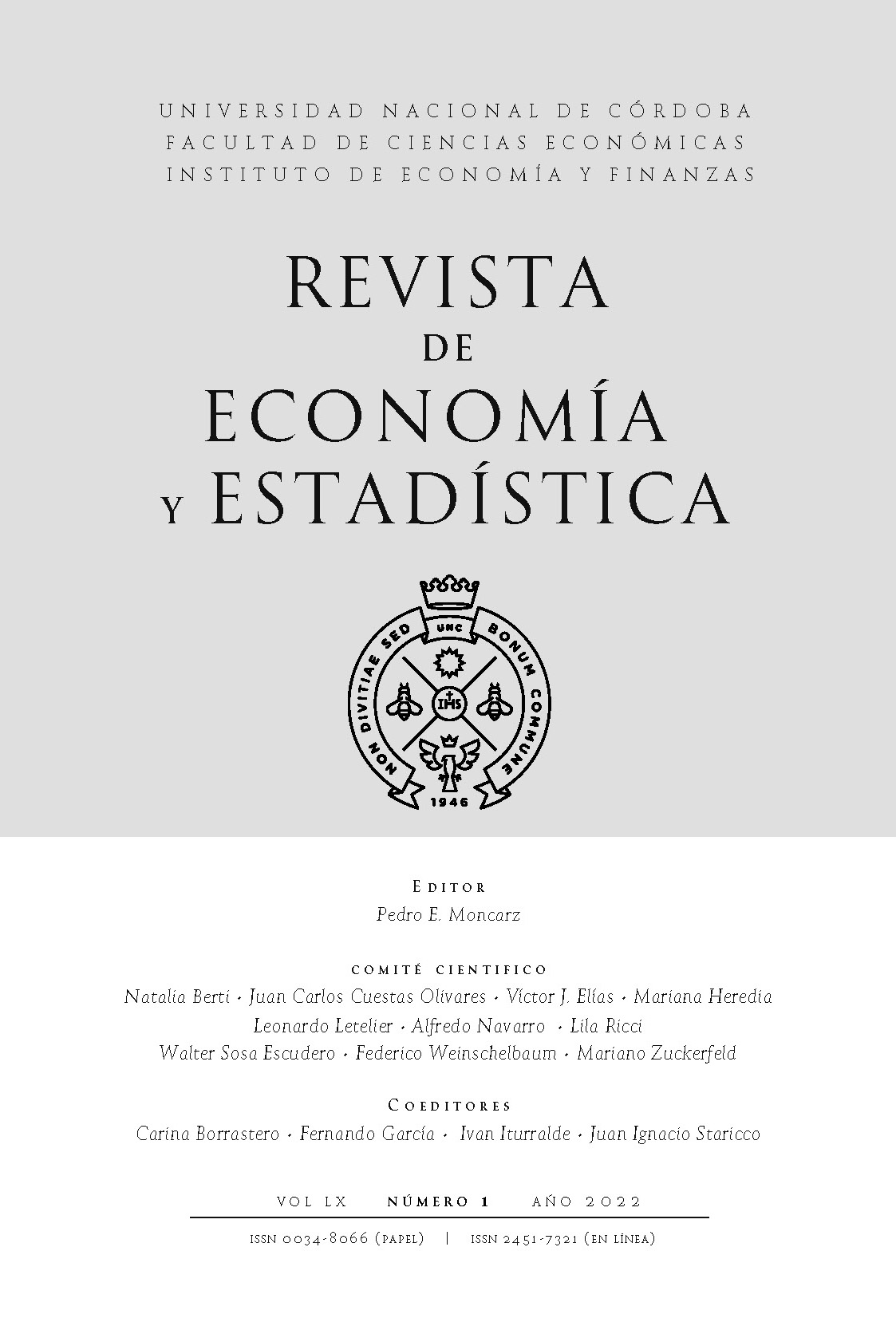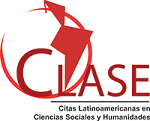Size and Position in Value Chains in Latin America with a regional Perspective
DOI:
https://doi.org/10.55444/2451.7321.2022.v60.n1.37801Keywords:
Regional integration, Global value chains, Input output models, Forward and Backward LinkagesAbstract
In this article, I develop a framework that divides global value chains into regional and extra-regional and studies the participation of Latin American countries in international fragmentation of production along 25 years of globalization. Measures of depth, position, and length are developed for each kind of value chain. Between 1990 and 2015 the engagement in activities related to international trade increased in every country in Latin America and the prevalent way of integration is in Extra Regional Value Chains. While South America engages mostly in value chains as a source of value added transformed by others, Central America participates more as end of chains and Mexico switched its position to a net forward position in regional value chains. Finally, the article examines the relationship between participation and length of the domestic segment of chains, finding differences among the kind of participation that each country performs.
Reception date: 29/05/2022
Acceptance date: 13/09/2022
Downloads
References
Amar, A. and M. Torchinsky Landau (2019). “Cadenas Regionales de Valor En América Del Sur.” Documento de Proyecto. CEPAL.
Antràs, P., and D. Chor (2013). “Organizing the Global Value Chain.” Econometrica 81 (6): 2127–2204.
Antràs, P.and D. Chor (2018). “On the Measurement of Upstreamness and Downstreamness in Global Value Chains.” Working Paper 24185. National Bureau of Economic Research.
Antras, P. and D. Chor (2021). “Global Value Chains.” 28549. National Bureau of Economic Research.
Antràs P., D. Chor, T. Fally, and R. Hillberry (2012). “Measuring the Upstreamness of Production and Trade Flows.” American Economic Review 102 (3): 412–16. https://doi.org/10.1257/aer.102.3.412.
Antràs, P., and A. De Gortari (2020). “On the Geography of Global Value Chains.” Econometrica 88 (4): 1553–98.
Banacloche, S., M.A. Cadarso and F. Monsalve (2020). “Implications of Measuring Value Added in Exports with a Regional Input-Output Table. A Case of Study in South America.” Structural Change and Economic Dynamics 52 (March): 130–40. https://doi.org/10.1016/j.strueco.2019.08.003.
Blyde, J. S., C.Volpe Martincus, and D. Molina (2014). “Fábricas Sincronizadas: América Latina y El Caribe En La Era de Las Cadenas Globales de Valor.” Informe Especial sobre Integración y Comercio. Inter-American Development Bank.
Borin, A., and M. Mancini (2019). “Measuring What Matters in Global Value Chains and Value-Added Trade.” Policy Research Working Paper 8804. The World Bank.
Bosma, N. S., I. Romero Luna, and E. Dietzenbacher (2005). “Using Average Propagation Lengths to Identify Production Chains in the Andalusian Economy.” Estudios de Economía Aplicada, 23 (2), 405-422.
CEPAL, NU (2016). “La Matriz de Insumo-Producto de América Del Sur: Principales Supuestos y Consideraciones Metodológicas,” Documentos de Proyectos, 702.
De Gortari, A. (2019). “Disentangling Global Value Chains.” Working Paper 25868. National Bureau of Economic Research.
De La Cruz, J., R. Koopman, Z. Wang, and S. Wei (2011). “Estimating Foreign Value-Added in Mexico’s Manufacturing Exports.” US International Trade Comission.
Durán Lima, J. and S. Banacloche (2021). “Análisis Económicos a Partir de Matrices de Insumo-Producto: Definiciones, Indicadores y Aplicaciones Para América Latina.” Documentos de Proyectos. CEPAL.
Eaton, J., and S. Kortum (2002). “Technology, Geography, and Trade.” Econometrica 70 (5): 1741–79.
Fally, T. (2012). “Production Staging: Measurement and Facts.” Boulder, Colorado, University of Colorado Boulder, May, 155–68.
Hummels, D., J. Ishii, and K. Yi (2001). “The Nature and Growth of Vertical Specialization in World Trade.” Journal of International Economics 54 (1): 75–96.
Johnson, R. (2018). “Measuring Global Value Chains.” Annual Review of Economics 10: 207–36.
Johnson, R.C., and G. Noguera (2012). “Accounting for Intermediates: Production Sharing and Trade in Value Added.” Journal of International Economics 86 (2): 224–36.
Koopman, R., Z. Wang, and S. Wei (2014). “Tracing Value-Added and Double Counting in Gross Exports.” American Economic Review 104 (2): 459–94.
Lalanne, A. (2020). “La Inserción Del Uruguay En Las Cadenas de Valor de América Del Sur.” Serie Estudios y Perspectivas de La Oficina de CEPAL En Montevideo. CEPAL.
Lalanne, A. (2021). “Measuring Value Circulation in Regional Chains: Assessing Two Alternative Methods in South America.” Documento de Trabajo/FCS-Decon; 06/21.
Lenzen, M., D. Moran, Keiichiro Kanemoto, and A. Geschke (2013). “Building Eora: A Global Multi-Region Input–Output Database at High Country and Sector Resolution.” Economic Systems Research 25 (1): 20–49.
Los, B., and M.P. Timmer (2020). “Measuring Bilateral Exports of Value Added: A Unified Framework.” In The Challenges of Globalization in the Measurement of National Accounts. University of Chicago Press.
Los, B., M. P. Timmer, and G.J. de Vries (2016). “Tracing Value-Added and Double Counting in Gross Exports: Comment.” American Economic Review 106 (7): 1958–66.
Miller, R.E., and U. Temurshoev (2017). “Output Upstreamness and Input Downstreamness of Industries/Countries in World Production.” International Regional Science Review 40 (5): 443–75.
Miroudot, S. and M. Ye (2018). “A Simple and Accurate Method to Calculate Domestic and Foreign Value-Added in Gross Exports.” MPRA Paper. September 1, 2018. https://mpra.ub.uni-muenchen.de/89907/.
Moncarz, P., M. Flores, S. Villano, and M. Vaillant (2021). “Determinantes de Los Niveles de Integración Regional En Las Dos Últimas Décadas.” CAF. http://scioteca.caf.com/handle/123456789/1790.
Olabisi, M. (2020). “Input–Output Linkages and Sectoral Volatility.” Economica 87 (347): 713–46.
Timmer, M. P., Erik Dietzenbacher, B. Los, R. Stehrer, and G.J. Vries (2015). “An Illustrated User Guide to the World Input–Output Database: The Case of Global Automotive Production.” Review of International Economics 23 (3): 575–605.
Wang, Z., S. Wei, X. Yu, and K. Zhu (2017a). “Characterizing Global Value Chains: Production Length and Upstreamness.” 23261. National Bureau of Economic Research.
Wang, Z., S. Wei, X. Yu, and K. Zhu (2017b). “Measures of Participation in Global Value Chains and Global Business Cycles.” National Bureau of Economic Research.
World Bank. (2019). World Development Report 2020: Trading for Development in the Age of Global Value Chains. World Bank Publications.
Xing, Y., E. Gentile, and D. Dollar (2021). “Global Value Chain Development Report 2021: Beyond Production.”.
Published
How to Cite
Issue
Section
License
Copyright (c) 2022 Alvaro Lalanne

This work is licensed under a Creative Commons Attribution-NonCommercial-NoDerivatives 4.0 International License.
Authors who have publications with this journal agree to the following terms:
Authors retain their copyright and grant the journal the right of first publication of their work, which is simultaneously subject to the Creative Commons Attribution-NonCommercial-NoDerivatives 4.0 International License that allows third parties to share the work provided that its author and first publication in this journal are indicated.
Authors may adopt other non-exclusive licensing arrangements for distribution of the published version of the work (e.g. depositing it in an institutional telematic archive or publishing it in a monographic volume) as long as the initial publication in this journal is indicated.
Authors are allowed and encouraged to disseminate their work via the Internet (e.g. in institutional telematic archives or on their website) before and during the submission process, which can lead to interesting exchanges and increase citations of the published work. (See The Open Access Effect)









